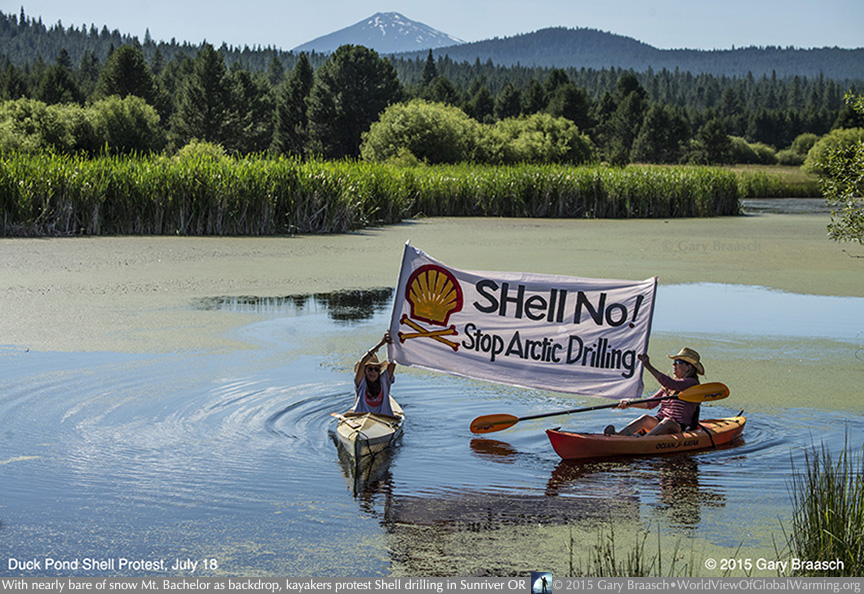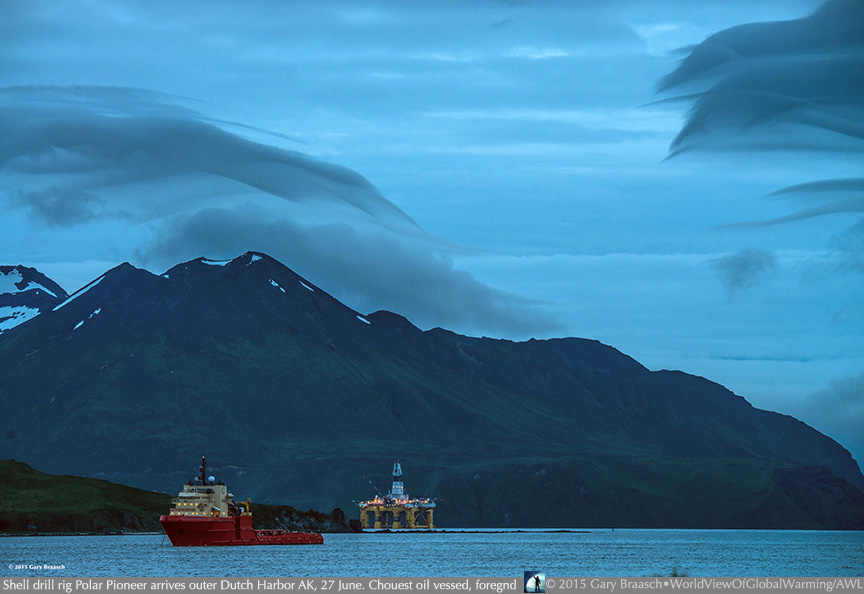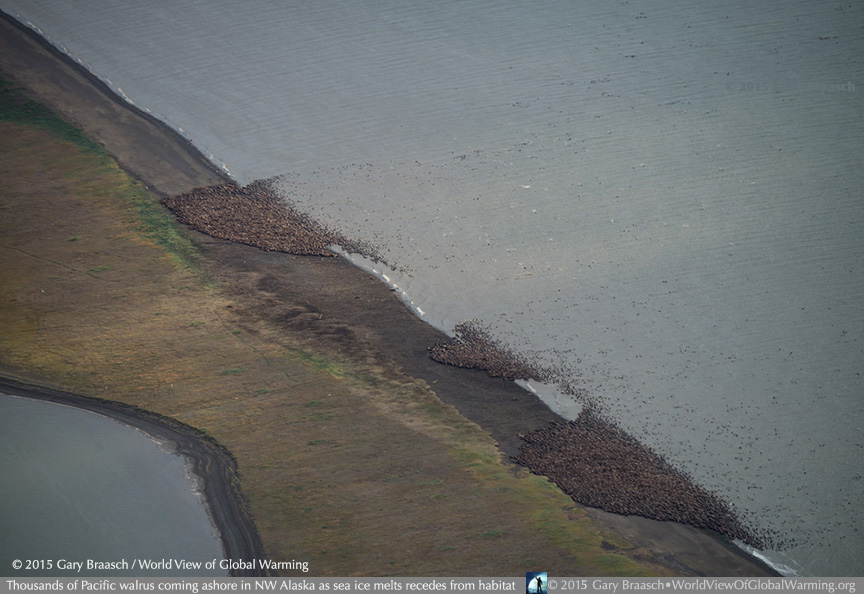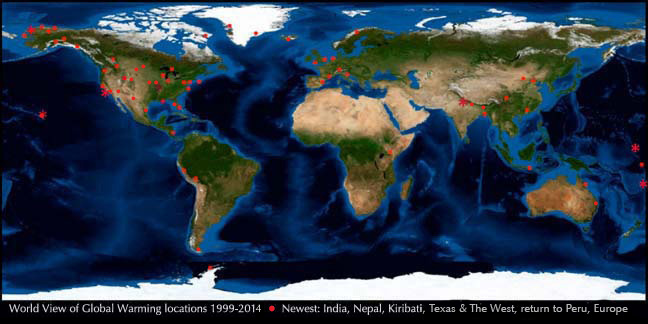Climate Photo of the Week
Shell quits Arctic oil drilling after “disappointing exploration outcome,” will “cease further exploration activity in offshore Alaska for the foreseeable future.”

Royal Dutch Shell itself has said “NO,” echoing the thousands of protesters it encountered this summer, stopping its Arctic oil drilling project in Alaska’s Chukchi Sea. In the surprise announcement on September 28, Shell said the oil and gas it found after drilling 6800 feet into the Arctic Ocean floor was "not sufficient to warrant further exploration in the Burger prospect. The well will be sealed and abandoned,” and the company would "cease further exploration activity in offshore Alaska for the foreseeable future.” The press release said Shell made the decision not only because of the "clearly disappointing exploration outcome” but also because of "the high costs associated with the project, and the challenging and unpredictable federal regulatory environment in offshore Alaska.”
A large part of that tougher “regulatory environment” was made possible by the constant pressure of environmental groups since the BP Gulf oil disaster to stop offshore oil exploration and sharply strengthen the rules and regulations imposed by the Interior Department on oil companies. Shell was dogged at every step this year by protests of thousands of kayaktivists and citizens — from Port Angeles and Seattle Washington to Unalaska Alaska and Portland Oregon where a crucial icebreaker had to be repaired and was delayed by a dramatic blockade of Greenpeace climbers hanging from a bridge.

Less visible was the constant lobbying and legal challenges by major environmental NGOs at the Interior Department’s oil and gas regulatory departments, which questioned every decision in Shell’s favor. Shell had been under great scrutiny since its drilling program in the Arctic in 2012 ended in damaged drill rigs and millions of dollars in fines, and was forced to add many extra safety technologies and oil spill recovery vessels to its fleet in the Arctic this year. The company ended up being granted the license to be the first company to drill for oil offshore in American Arctic waters after spending an estimated $7 billion in buying the leases, attempting the mistake-ridden 2012 exploration, and organizing the regulatory and technical resources for this year. Millions of Americans questioned the Obama Administration’s final go-ahead for Shell to try to find yet more petroleum, while the White House was announcing many strong policies to limit greenhouse gases from vehicles and power plants, and through building efficiency and renewable power programs.
Some environmental experts and financial analysts cautioned that Shell’s statement has many conditional words. The very meaning of “the foreseeable future” is unknown, since for most of the past few years Shell’s apparent future was couched in terms of developing the Chukchi Sea oil resource over the next 15-30 years. There was no indication why the drill hole came up dry, with the USGS and Shell having touted the “vast” amount of oil which seismic testing showed was available, estimates ranging up to 30 billion barrels of oil, exceeding the Prudhoe Bay oil field 150 miles to the east. Shell will not only take a $3 billion or more write-down on the project, but is also suffering falling earnings that are half of what they were last year because of the crash in oil prices. Analysts were quoted that there was skepticism that Shell could get a high rate of return on the drilling, especially since even with full success Arctic exploration and exploitation is much more costly than other plays. Also mentioned was a worry that Hillary Clinton, who has said she considered Arctic drilling too risky, would become president and cancel the leasing program. But rising oil prices, continuation of the leasing under the next Administration, and competition among oil giants if world action to cut global warming carbon pollution is too little — these could resurrect American Arctic drilling. Some of the groups who fought Shell every step and paddle of the way this year vowed to move immediately to advocate putting all of the American Arctic off limits to oil exploration. A bill was introduced in the House to do just that, on the same day Shell made its announcement; some Senators have also written a bill to stop drilling.
Shell’s final days of drilling were the silent backdrop to the unprecedented visit of President Obama to Alaska, where the drilling went unmentioned as he spoke of the dangers of climate change while standing before shrinking glaciers and talking with fishers and native Alaskans whose lives are threatened by rapid warming in the Arctic. Presidential Science Advisor John Holdren gave a briefing on Alaska climate changes including showing photographs by Gary Braasch of a beaching of Pacific walrus because their regular habitat, sea ice, had melted away — the seventh time in nine years that the sea mammals had faced loss of their habitat near Alaska. U.S. Fish and Wildlife officials said more than 700 walrus had swum past the Shell drilling ships and rigs as they made their way to the shore near Point Lay, Alaska. This confirmed the dangers to protected sea mammals not only from the physical presence of noisy drilling work in their habitat, but also from the effects of burning fossil fuels on the crucial sea ice cover of the Arctic Ocean.

One of the strongest statements about the drilling and Shell’s reversal of its plans was in the Los Angeles Times editorial:
"This is an opportunity for the federal government, which never should have allowed the Shell project to go forward, to reevaluate its policies in the still-pristine waters off Alaska. At this point, the nation's energy efforts should be focused on cleaner sources that don't contribute to global warming, thus protecting the Arctic from both drilling and from the already troubling effects of climate change.”
More on the Shell decision to stop drilling:
15 years of World View of Global Warming, documenting climate change 1999-2015

This project would be impossible without scientists and observers around the world who have provided hundreds of scientific contacts and papers. See Background, Advisors, and Reference for documentation, funders and major advisors, without whom I could not complete the work.
World View of Global Warming is a project of the Blue Earth Alliance, Seattle Washington, a 501(c)3 tax-exempt organization. The project is supported entirely by donations, grants, and license fees for the photographs. Please see information about how to contribute.
For other information about Gary Braasch's climate change projects and books, please see the books Earth Under Fire and How We Know What We Know About Our Changing Climate, and the exhibit "Climate Change in Our World" at the Books and Exhibits link on the top menu of this page.
COPYRIGHT NOTICE:
Photography and text Copyright © 2005 - 2017 (and before) Gary Braasch All rights reserved. Use of photographs in any manner without permission is prohibited by US copyright law. Photography is available for license to publications and other uses. Please contact requestinformation@worldviewofglobalwarming.org. View more of Gary Braasch's photography here.



